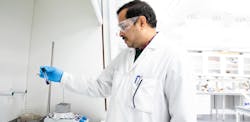Call it “yellow journalism,” but who could pass on an article with “piss and vinegar” in the headline?
Robert Schoenberger, editorial director for the manufacturing group here at Endeavor Business Media, sent the article my way, and I felt a sudden urge to … write about it.
Besides, I’ve already written about beer so why not something about its eventual byproduct?
In any event, “Piss and vinegar: ingredients for ecofriendly battery recycling,” was the headline for an article on Anthropocene, a news site focused on climate science.
The article details how a research team from Linnaeus University in Sweden and the Indian Institute of Technology Madras in India developed a new battery recycling method that extracts valuable metals from lithium-ion batteries.
The process involves a solvent composed of two chemicals, one sourced from urea found naturally in urine and the other derived from acetic acid.
The primary advantage of the novel solvent, in contrast to commonly employed techniques for cobalt recycling, lies in its ability to operate at significantly lower temperature -- 180 degrees Celsius versus 1,400 degrees Celsius for conventional commercial options, says Ian Nicholls, professor of chemistry at Linnaeus University.
Cobalt is in high demand and is projected to continue its upward trend, according to the news release. But the recycling rate for discarded batteries remains quite low. This is problematic for several reasons.
“Today’s methods for recycling cobalt from batteries come with many drawbacks. They require significant amounts of energy and create biproducts that are dangerous for both humans and the environment. With more efficient and environmentally friendly methods, we can reuse a very significant portion of the cobalt that is already in use, instead of mining," says Nicholls.
The process can recover about 97% of the cobalt in a lithium-ion battery, according to the press release.
So, instead of pissing away valuable material, the researchers say their method could help scale future battery recycling efforts.
“The combination of readily available and relatively harmless substances and high energy efficacy gives our method potential to work for large scale extraction,” says Nicholls.
About the Author
Jonathan Katz
Executive Editor
Jonathan Katz, executive editor, brings nearly two decades of experience as a B2B journalist to Chemical Processing magazine. He has expertise on a wide range of industrial topics. Jon previously served as the managing editor for IndustryWeek magazine and, most recently, as a freelance writer specializing in content marketing for the manufacturing sector.
His knowledge areas include industrial safety, environmental compliance/sustainability, lean manufacturing/continuous improvement, Industry 4.0/automation and many other topics of interest to the Chemical Processing audience.
When he’s not working, Jon enjoys fishing, hiking and music, including a small but growing vinyl collection.
Jon resides in the Cleveland, Ohio, area.


